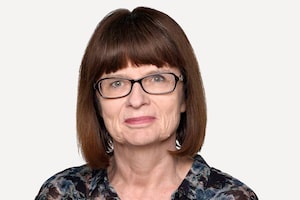Rinelle Harper receives attention from her mother, Julie Harper, while in her hotel bed in Winnipeg Nov. 19, 2014.The Globe and Mail
I have heard from two readers over the past week who were concerned that The Globe and Mail published a front-page photo of Rinelle Harper, the 16-year-old victim of a gruesome attack in Winnipeg this month.
The readers were confused as to why The Globe would publish her photo when at a press conference the day before she had asked that her face be concealed. They didn't know that the newspaper had an exclusive interview with the family in their hotel room on the eve of the press conference and obtained explicit permission to take and publish photos of Rinelle and her family.
"What possessed you to put a photograph and article of Rinelle Harper on the front page of yesterday's Globe and Mail? When Rinelle had expressly asked that no photographs of her face appear in the media?" one reader asked.
Another said the following: "I don't know Rinelle Harper but the one request this brave girl asked of the media was not to show her face yet, presumably until she has had more time to recover from her horrid ordeal. [But] you saw fit to disregard her wish and put her picture on your front page. … A shameful decision."
I certainly respect and appreciate the readers' concern for Rinelle Harper's well-being, but in this case they are wrong.
Both Rinelle and her family have been courageous in dealing with her assault and near-death experience, and also in allowing her name to become public. The latter decision was made in an effort to help police solve the crime, but it also put a face on the serious issue of missing, beaten or murdered aboriginal women in our country.
The Globe and Mail takes the issue very seriously as does the reporter on the story, Kathryn Blaze Carlson. After the teen was discharged from the hospital on Nov. 14, Ms. Carlson reached out to members of the Harper family – both Rinelle's mother and another relative, Grand Chief David Harper – to arrange an in-depth interview with Rinelle and her family. The interview was scheduled for early the following week in Winnipeg.
The Globe felt that it was important not only to illustrate how Rinelle fits into the trend of violence against aboriginal women, but also to tell the girl's story. She was nearly a statistic, but Rinelle is her own person, with her own history and her own dreams. Her parents agreed that this was important to share with Canadians, and the family spent more than an hour with Ms. Carlson on the evening of Nov. 19. Grand Chief Harper was present at the outset of the interview.
After a thoughtful discussion that evening, Rinelle explicitly agreed to having her photo taken and published. Neither she nor her parents asked for any restrictions, nor have they since. In fact, Ms. Carlson was in touch with Rinelle's parents over the weekend and this week, and they asked if The Globe could send along one of the family photos shot by the local freelance photographer.
Indeed, Ms. Carlson had permission from all concerned for both the interview and the photographs on the Wednesday evening before Rinelle's public appearance at the Nov. 20 press conference.
At the press conference, Rinelle and her family told various local and national media outlets that the girl didn't want her face filmed or photographed at the event. The Globe respected those wishes, and published only a side profile taken of Rinelle from that press conference.
The Globe and Mail has been very respectful of Rinelle and her family, and has honoured their wishes throughout its responsible coverage of this terrible crime.
The stories, about Rinelle, her family and her rescuers, show that sensitivity and respect.
 Sylvia Stead
Sylvia Stead